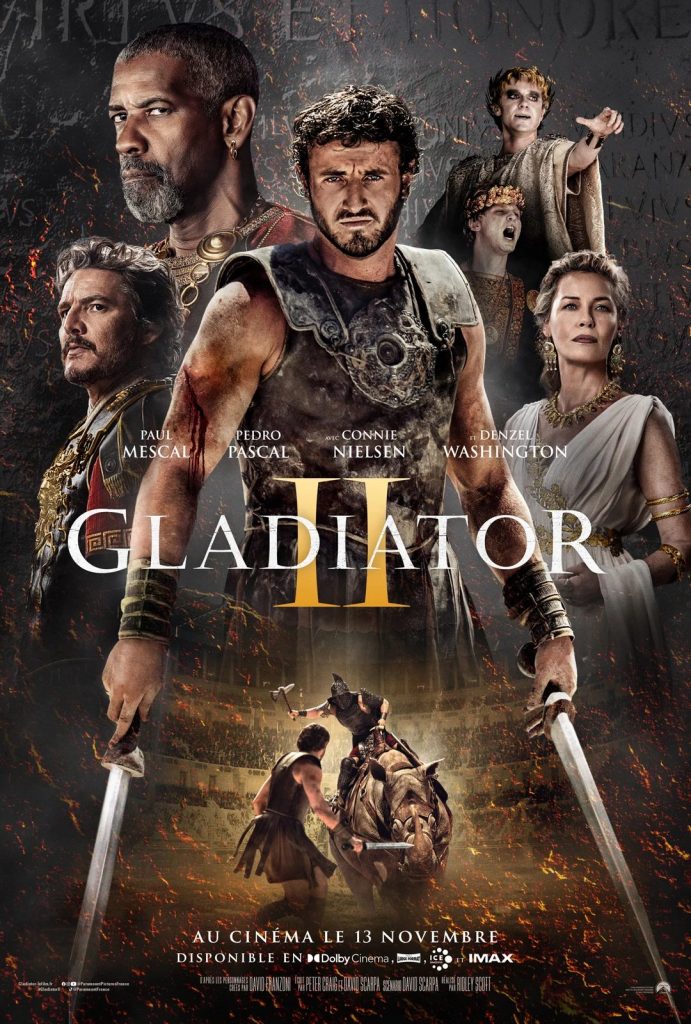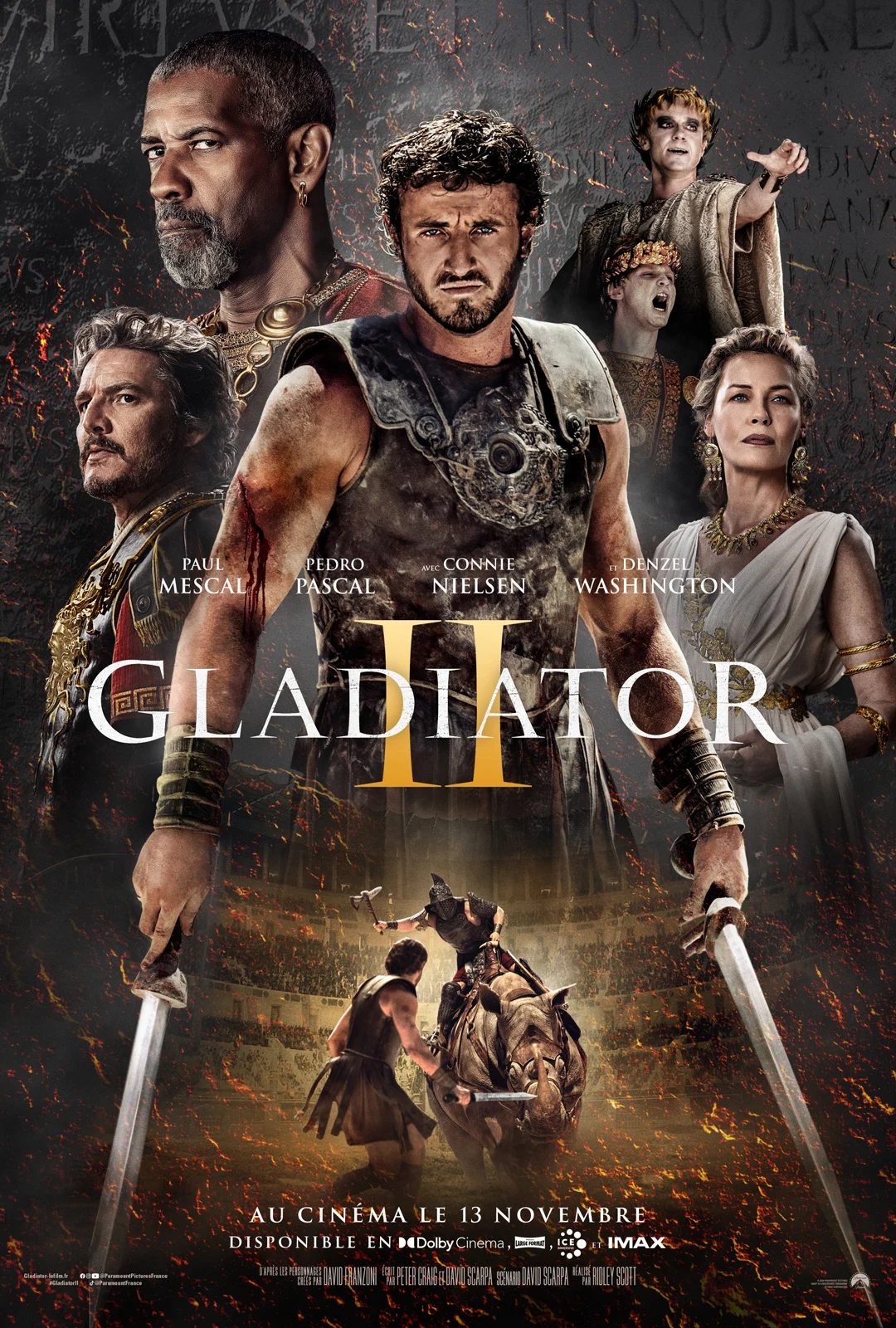Character Insights

- Lucius (Paul Mescal)
- Lucius, now an adult, is the central figure in the story. He’s portrayed as someone torn between his noble lineage and the weight of his uncle Maximus’s legendary reputation. Raised under his mother’s care, Lucius is idealistic yet hesitant to embrace the violence and rebellion required to challenge Rome’s corruption.
- Development: Lucius transforms from an introspective individual into a fearless leader. Inspired by Maximus’s sacrifice, he forges his identity as both a gladiator and a visionary, seeking to unite Rome’s divided people.
- Marcus Acacius (Pedro Pascal)
- Marcus is a layered character, blending charm with mystery. A mentor-like figure to Lucius, his allegiances remain ambiguous, keeping viewers guessing whether he supports the rebellion for personal gain or moral conviction.
- Role: Marcus’s decisions greatly influence Lucius’s path, and his complex backstory ties into Rome’s political and military elite.
- Macrinus (Denzel Washington)
- A wise and commanding presence, Macrinus acts as a counterbalance to Rome’s oppressive rulers. While his methods may clash with Lucius’s ideals, Macrinus helps him understand the nuances of leadership and rebellion.
- Impact: Denzel Washington’s role as Macrinus is pivotal in grounding the narrative, offering depth and gravitas in moments of reflection and action.
- Emperor Geta (Joseph Quinn)
- Geta is an embodiment of Rome’s decline into corruption. A cunning and ruthless leader, his decisions worsen the empire’s internal strife, setting the stage for rebellion.
- Conflict: As a direct antagonist, Geta views Lucius as a threat to his rule and uses the Colosseum as a stage to assert his dominance.
- Lucilla (Connie Nielsen)
- Lucilla, the mother of Lucius, continues to play a significant role in the sequel. Her wisdom and resilience are central to Lucius’s moral compass, though her protective instincts often conflict with his dangerous ambitions.
- Emperor Caracalla (Fred Hechinger)
- Caracalla adds another layer of conflict. Known for his historical tyranny, he serves as a rival to Geta, creating a web of political intrigue and betrayal within Rome’s leadership.
- Historical Context: Caracalla is infamous for his cruelty and the damnatio memoriae (condemnation of memory), symbolizing the fragility of power in Rome.
Historical Inspirations
- The Roman Empire’s Decline
- The sequel is set during a period of political instability and decadence in Rome. While Gladiator II takes creative liberties, it draws heavily from the internal conflicts and moral decay that defined Rome’s later years.
- Themes of rebellion and corruption reflect the struggles of real historical figures and the tensions within Rome’s leadership.
- The Gladiator Tradition
- The Colosseum continues to serve as a symbol of both Roman glory and barbarity. The film explores the spectacle of gladiatorial combat as both entertainment and a tool of political control.
- Lucius’s journey through the Colosseum mirrors the transformation of his uncle Maximus, showcasing how the arena shaped heroes in Rome’s tumultuous history.
- Emperors Geta and Caracalla
- The antagonists are loosely inspired by historical figures. Geta and Caracalla were actual Roman emperors known for their power struggles, reflecting the internal divisions within the empire. Their rivalry and political machinations provide a dramatic backdrop for the narrative.
- Maximus’s Legacy
- Though Maximus is no longer alive, his ideals of honor and sacrifice linger in Lucius’s story. The film uses his memory as a driving force for Lucius’s rebellion, blending historical inspiration with emotional resonance.
Behind-the-Scenes Insights
- Ridley Scott’s Vision
- Scott has described Gladiator II as not merely a sequel but a continuation of the philosophical and political themes explored in the original. The film expands on the idea of what it means to fight for freedom in a corrupt world.
- Practical and Visual Effects
- True to the original, much of the sequel relies on practical effects and on-location shoots in Morocco to recreate ancient Rome. CGI is sparingly used to enhance large-scale battle scenes and architectural grandeur.
- Epic Combat Scenes
- The Colosseum remains central to the story, with fight sequences designed to outdo the original in scale and intensity. Choreographers have incorporated both traditional Roman fighting styles and creative modern interpretations to create breathtaking combat.
- Music Score
- While Hans Zimmer crafted the iconic score for Gladiator, the sequel features a new composition inspired by Zimmer’s themes, incorporating a blend of orchestral power and haunting melodies that evoke Roman history.
Why Fans Are Excited
- Nostalgia Meets New Challenges
- Gladiator II brings back beloved elements from the first film while introducing new characters, conflicts, and moral dilemmas.
- A Star-Studded Cast
- With Denzel Washington, Pedro Pascal, and Paul Mescal leading the cast, the film promises powerful performances.
- Expanding the Universe
- The sequel expands on the mythology of Maximus and the political and social dynamics of ancient Rome.
Let me know if you’d like more specific insights into themes, production notes, or character arcs!








